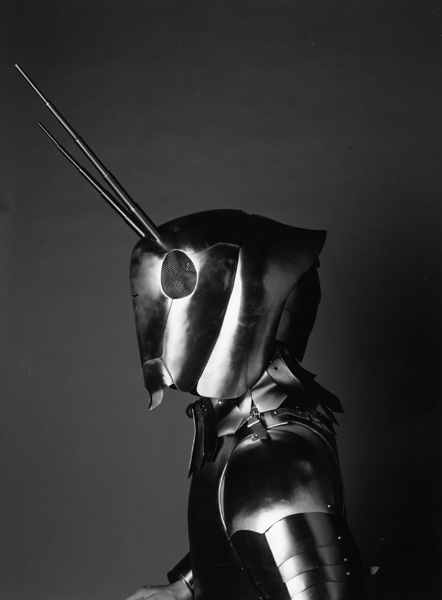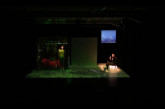La bella mostra Jan Fabre Stigmata. Actions & Performances 1976-2013 (a cura di Germano Celant, visitabile fino al 16 febbraio 2014 al MAXXi di Roma), ripercorre ventisette anni di attività espressiva con una struttura insieme vasta e asciutta. Quasi evitate le grandi forme (come i Frati di ossa esposti in passato) la mostra allinea segni, oggetti, video-azioni, foto, coltelli e mannaie, come in un’inquietante “cantina da serial killer”, oppure una Wunderkammer dove il gusto del macabro, le vanitas e il suo amore per la pittura classica si esprimono.
Ma c’è anche una serie d’immagini esemplari che sono i suoi appunti-prova, la modalità intorno a cui costruisce le sue immagini-racconto. Un susseguirsi di situazioni, di scontri contro la società e la cultura, di ferite e di vendette. Il giovanissimo Jan Fabre delle prime performance ha l’incredibile età di diciannove anni, eppure la capacità, la superbia e la protervia per rompere tutto, come un Johnny Rotten della cultura visiva, un Punk perdente che ha però la sapienza per sopravvivere e vincere. Per lui gli esseri umani non sono poi così lontani dagli insetti, anzi questa vicinanza è identificazione, gli uomini sono insetti.

Lyon, Les Subsistances
© Angelos Bvba. Foto: Malou Swinnen
Jan Fabre’s beautiful exhibition, Stigmata Actions & Performances 1976-2013, traces twenty-seven years of artistic activity employing a structure that is both as dry as it is vast. The show neglects large sculptures (like the bone Monks, exhibited in the past) and aligns signs, objects, action-videos, photos, knives and cleavers, like the disturbing “Cellar of a serial killer”, or maybe like a Wunderkammer that expresses his taste for the macabre, for vanitas and his love for classical painting. But there is also a series of pictures: a sample of the sketches that constitute the source of the artist’s narrative images. It is a succession of situations, of cultural and social clashes, of wounds and of revenge. Although the Jan Fabre that we see in the first performances is extremely young (barely nineteen), he has the ability, the pride, to break everything he knows; like a Johnny Rotten of the visual arts, he is an punk underdog who knows what it takes to survive and to win. For him, insects are not so different from humans; more precisely, they can identify with bugs: humans are insects.
Lorenzo Taiuti
D’ARS year 53/nr 216/winter 2013 (abstract dell’articolo)
Acquista l’intero numero in formato epub/mobi oppure abbonati a D’ARS





